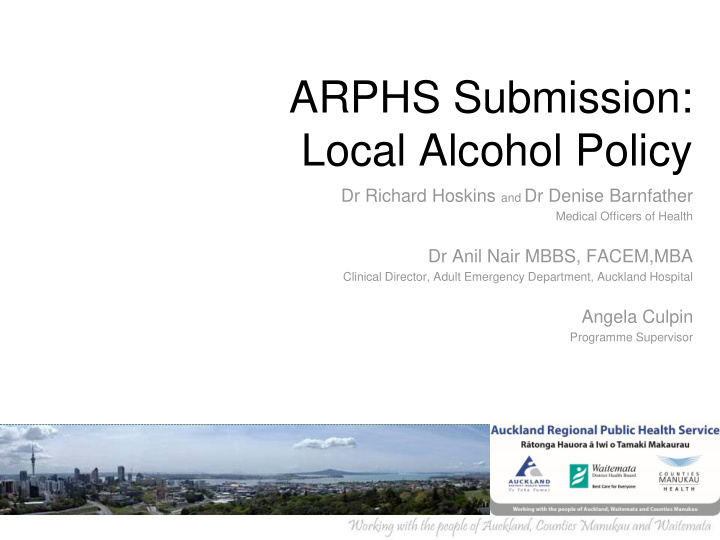



ARPHS Submission: Local Alcohol Policy Dr Richard Hoskins and Dr Denise Barnfather Medical Officers of Health Dr Anil Nair MBBS, FACEM,MBA Clinical Director, Adult Emergency Department, Auckland Hospital Angela Culpin Programme Supervisor
THE IMPACT-PERSONAL
IMPACT – FAMILY AND SOCIETY
ALCOHOL + DRIVING =SIGNIFICANT HARM….PERMENANT DISABILITY…DEATH Relationship of blood alcohol concentration and crash responsibility
What we know – ED presentations • Median amount of alcohol consumed -14 standard drinks (up to 71 STD) • Alcohol sourced – Liquor stores (48%) – Supermarkets (22%) – On licence premises (26%) – Home brew/duty free(4%)
What can society do ?
Local alcohol policy • Reduce hours of sale of alcohol • Reduce number of outlets
Our Purpose • Helping achieve the object of the Act through the Auckland LAP, specifically – Sale, supply, consumption of alcohol should be undertaken safely and responsibly – Harm caused by excessive or inappropriate consumption of alcohol should be minimised
Our Evidence • We are public health experts who care, we have no conflicts of interest • Our primary interest is improving public health • Our submission draws on extensive local, national and international evidence • In particular we present survey information from the Auckland community about what they want
Evidence: The 5+ Solution 1. Raise alcohol prices 2. Raise the purchase age 3. Reduce alcohol accessibility 4. Reduce marketing and advertising 5. Increase drink-driving counter-measures PLUS: Increase treatment opportunities for heavy drinkers Based on Babor et al (2003) Confirmed by Anderson et al (2009)
Harm • >200 diseases 1 • Carcinogen 2 • Neurotoxin 3 • No safe ‘lower limit’ 4 • 600-1000 deaths/year NZ 5 World Health Organization (2014). ‘Alcohol’ Fact Sheet. Updated May 2014. Date accessed: 12 June 2014. Accessed from: http://www.who.int/mediacentre/factsheets/fs349/en/ 1. 2. Alcohol was first identified as a carcinogen by the IARC Working Group in 1988. International Agency for research on Cancer (1988). Alcohol drinking (IARC Monographs on the Evaluation of the Carcinogenic Risk to Humans). Lyon: World Health Organization. 13-20. The United States Department of Human and Health Sciences (2000).The 10th special report to the U.S. Congress on Alcohol and Hea lth. ‘The neurotoxicity of alcohol’. 3. Accessed from: http://pubs.niaaa.nih.gov/publications/10report/chap02e.pdf 4. Rehm J, Shield K. (2014) Alcohol consumption. In: Stewart BW, Wild CB, eds. World Cancer Report 2014. Lyon, France: International Agency for Research on Cancer. 5. Berl 2009; Connor et al 2005.
Cost • $4.9 billion per year 6 – Cost benefit analysis using internationally recognised methodology from WHO 7 • $120 million per year 8 – Health system cost 6. Ministry of Health (2010). ‘Alcohol quick facts’. Accessed from: http://www.arphs.govt.nz/Portals/0/Health%20Information/Alcohol%20and%20Tobacco/ARPHS%20Alcohol%20and%20Tobacco%20service/alcohol-factsheets.pdf 7. Slack, A., Nana, G., Webster, M., Stokes, F., & Wu, J. (2009). Costs of harmful alcohol and other drug use. BERL Economics, Page 40. 8. Single E, Collins D, Easton B, Harwood H, Lapsley H, Kopp P, and Wilson E. (2003). International Guidelines for Estimating the Costs of Substance Abuse. Second edition. Geneva: WHO.
The world’s most “Liveable city” … … won’t have an alcohol problem International indices of “ liveability ”: • Lack of crime, personal safety and low personal risk. • Health care (better health outcomes, more Auckland hospital emergency capacity). Major economic gains – reduced alcohol related costs. Liveable cities attract economic investment. Community wants: • More entertainment where alcohol is not the main focus • For many …“a reduction in bars and taverns would make them more likely to visit the CBD for shopping and to visit cafes and restaurants.”
Auckland plan targets – effective alcohol policy Auckland plan targets – Through reducing alcohol harms in LAP. Ensure that the incidence of trauma from road crashes caused by alcohol , speeding or lack of restraints will be in line with nationally set targets by 2020. There will be no gaps in life expectancy between European, Māori, Pacific and Asian ethnicities by 2040. By 2020 the number of breaches of the Domestic violence Act (1995) will have stabilised and by 2040 will have fallen by 40%. Decrease the number of child hospitalisations due to injury by 20% by 2025.
Recommendations: Hours On licences • 10am – 1am consistent closing for the entire Auckland region • No trial extensions of hours for best practice operators • ( One way door policy in lieu of consistent trading hours) Off licences • 10am - 9pm , no exceptions for supermarkets • Off-licences near schools shut 3pm - 4pm on school days. Plus: other recommendations outlined in our written submission on this issue Supported by Evidence and Auckland Public in our community survey
Recommendations: Density On licences: • Density controls , freeze* or sinking lid in broad area A, neighbourhood areas and all priority overlay areas for a six year period. • Entire city centre, Broad Area A -reclassified as Priority Overlay Area due to high alcohol-related disorder and to prevent displacement. Off licences: • Freeze* for six years (the length of the policy). • Freeze* or sinking lid policy for broad area A, neighbourhood areas and the priority overlay. Plus: all other recommendations outlined in our written submission on this issue * Except for new developments / land use change Supported by Evidence and Auckland Public in our community survey
Recommendations – location, proximity • Buffer zones schools and sensitive sites to alcohol premises. • Support the proposed definition of sensitive sites (+ rest homes). • If buffer zones not approved – we recommend robust notification process - all residents near sensitive sites actively notified of licence applications. • Support the use of environmental cumulative impact assessments ( ECIAs ), completely separated from alcohol industry funding/influence. Plus: all other recommendations outlined in our written submission on this issue Supported by Evidence and Auckland Public in our community survey
Thank you • As is required Auckland Council has consulted the Medical Officer of Health appropriately • This LAP is a good start, our recommendations (which are in line with community aspirations) will further strengthen the LAP
Recommend
More recommend